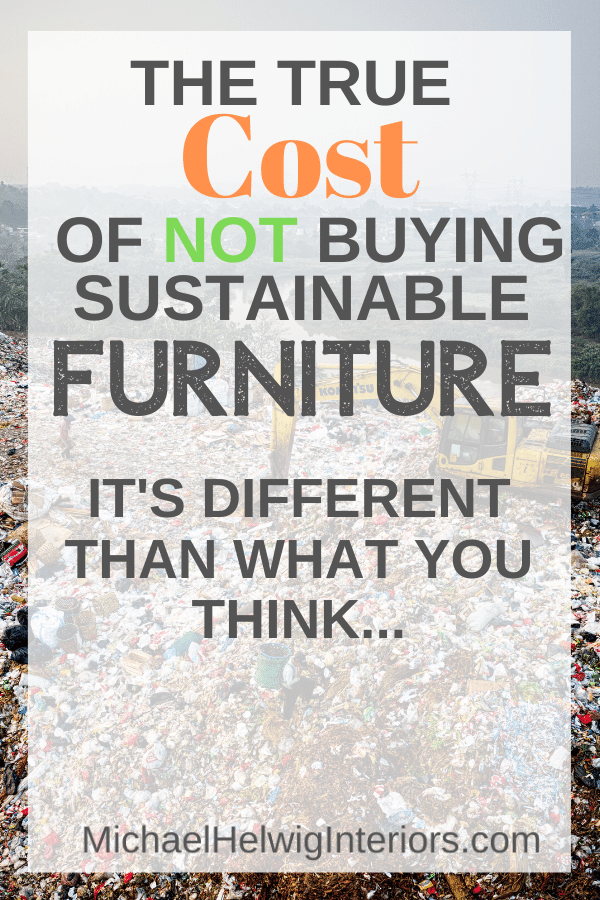I see it out the front window every week: my neighbor’s curbs lined with furniture. As the weather breaks here in the Northeast U.S., people are getting the itch to clear out their homes to make space for the new.
Spring is in the air and that means new life for most of us suffering from cabin fever. It also means new projects around the house: fresh paint, a do-it-yourself project or two, or maybe the revitalization of a tired decorating style in favor of something different. Most likely, new. It’s understandable. We’ve been cooped up and staring at the same stuff for months, right?
About this time, you start seeing the commercials for 0% financing on new furniture. Your mailbox gets stuffed with catalogs and flyers brimming with stealth marketing messages crafted to woo you with irresistible offers. It’s almost like they’re reading our minds with some of these ads… How did they know you want a living room makeover? Do they have a crystal ball?
Most likely, no. The truth is, we are conditioned to accept these carefully crafted messages because they show up everywhere, over and over. We not only see the commercials on TV, we find them creeping up in our internet searches, on social media and in print. It’s all part of the plan. Watch anything on Hulu and you’ll likely see the same 1 or 2 commercials played during every break, Progressive Insurance anyone? So, the furniture companies aren’t reading our minds, they’re telling us repetitively what they want us to do.
According to The Financial Brand, a digital publication focusing on marketing and strategy issues affecting retail banks and credit unions, “Studies suggest that repeated statements are perceived as more truthful than statements made less frequently, “presumably because repetition imbues the statement with familiarity.” In simple terms: frequency breeds familiarity, and familiarity breeds trust.”
Let me dial back the conspiracy here and get to the point… It’s not about the “evil media” companies luring unsuspecting consumers into furniture purchases. It’s about how we, as a culture, got to the point that we value consuming new furniture over conserving the old. The adage: “waste not, want not” seems to be dying faster than a polar bear on a melting glacier. If that is a little rough for a decorating blog, sorry. There’s good reason for it…
According to the Environmental Protection Agency, 12.2 million tons of furniture and furnishings were discarded in 2017. That is up from 2.2 million tons discarded in 1960. 80.2% of that discarded furniture ended up in landfills while most of the remaining 19.5% was combusted for energy recovery.
This goes to show that today, we are far more likely to casually discard furniture 6 times more often than our grandparents did, 60 years ago. That’s literally the opposite of ‘waste not, want not’, right?
Think about this, how many times have you bought new furniture instead of brought old furniture to a new place? There’s probably a pretty good chance that some furniture didn’t make the cut. Maybe it was too big or too small. If that was your experience, I would also bet that instead of donating it or passing it along to someone else, it ended up by the dumpsters or on the curb, right? This is by no means a judgement and I know that moving stuff you don’t love from one place to another can be a drag. These days, if we’re tired of something, or if we feel like it’s out of style, or in need of repair, out it goes with little thought to the resulting consequences.
Check out how to calculate your carbon footprint:
So, what changed? What was the reason for this staggering increase in discarded furniture? There has to have been a tipping point when the collective value system changed, right?
Not so long ago, furniture was made for function more than aesthetics. It was produced to accommodate a need: beds were needed for sleeping, tables for eating at and so on. The homes of average people weren’t filled with the latest furniture and decoration. Unless you were the wealthy elite, your home was most likely not. Pinterest. ready.
That all changed in the 1950’s when kitchens began being constructed using particle board. At first it was more expensive than solid wood but in a short time, industry developed cheaper ways to produce it using cheap chemical adhesives and glues. Just as in any business, innovation, cost and technology will influence what the consumer finds in the market. Since particle board became an inexpensive material, and in order to remain competitive, companies iterated from building furniture with solid wood to using particle board. Suddenly the average person, who was previously excluded from the world of home fashion, had an in.
This caused a shift in the consumer furniture shopping market which increased demand for less expensive options for this emerging market. Now the heat was on to produce more furniture in less time to keep up demand.
Innovators answered the call in 1963 with the introduction of Polypropylene, a thermo plastic polymer resin. This new introduction had great impact on and usefulness to the furniture industry. It was light, which made it cost effective to ship, and it was highly customizable: it didn’t degrade when color was added. That was good news for furniture producers because it meant more choices and higher chances for profits.
Next up was the development and widespread use of Polybrominated diphenyl ethers, (PDBEs), known commonly as “flame retardants”. These chemicals were added to upholstery to slow or stop fire. Even today, between 700 and 900 people still die each year as a result of fires caused by cigarettes. The application of fire retardants did not change the color or feel of the fabric it was applied to, which was great news for the Don Drapers of the world but, to what avail?
To answer that question, we have to get into what we’ve learned along the way and how that knowledge relates to the increasing 80.2% of furniture dumped into in landfills. In the piece titled: “The History of Mass Produced Furniture in America,” by Pureinfographics, the author writes, “With time, the toxic chemicals disintegrate into dust. In homes, PDBEs lower the quality of indoor air and pose health risks. In landfills, the chemical effects sewage, soil quality and water. Health risks attributed to exposure of PDBEs include delayed development, decreased intelligent quotient levels, infertility, thyroid disorders, cancer and memory problems. The chemicals are so common that up to 97% of Americans have traces of it in their blood.” Holy hell, if that isn’t THE reason to reconsider how we manage furniture disposal, I don’t know what is! And that’s just the effects on people, not nature at large.
In addition to that, Polypropylene, the big innovation of 1963, takes up to 30 years to completely decompose in landfills but not before messing up some other stuff along the way. According to The Balance Small Business, from May 2019: “Additives used in plastic products may contain toxins such as lead and cadmium. Studies suggest that cadmium contained in plastic products has the potential to percolate and can have extremely harmful consequences for a number of bio-systems. Also, the burning of thermoplastics like PP can discharge dioxins and vinyl chloride.” The careless disposal of polypropylene equals no good news for people or the environment.
Has the knowledge of chemical pollutants in discarded furniture changed how furniture is manufactured today?
You bet it has and that’s the good news. In 2020, the possibility of furniture manufacturers flying under the radar of production standards is slim to none. “Sustainability was once considered a lofty goal pushed for only by the most progressive, unrealistic companies. Today, however, attitudes towards sustainability have shifted dramatically, and it is virtually a necessity for any successful business to participate in green initiatives… From the wood used for frames to the fabric and chemicals used to finish pieces of furniture, there is a lot that goes into sustainable sourcing and production, and consumers are doing the research to ensure that the furniture they buy is environmentally friendly.” (Source: Furniture Today, February 4, 2020).
So, Michael, you’ve raised a lot of fuss here, what’s your beef, really?
Let’s circle back to the need for new: Our instant gratification culture is causing a colossal negative impact on the environment. As a result of constantly being inundated with messages that we need to have the latest furniture and the hottest home trends, we’re making poor choices when it comes to the furniture we purchase. The most affordable furniture available IS what’s filling up the landfills fastest.
These days we don’t have to wait to invest in an expensive piece of furniture that will last and hold up to everyday use. We can go to our local big box store and pick up an entire room full of ready to assemble furniture for just around $1000.00. This is referred to as “fast furniture” and much like fast food, it’s not doing us any favors. “Furniture is the least-recycled household item and furniture is the second largest portion of urban waste. It’s made of cheap materials that aren’t meant to last, and its limited life span means increased waste in landfills.”
The strides made by furniture manufacturers to bring the harmful chemical waste of furniture production down cannot compare to the amount of ‘fast furniture’ discarded every year.
The fact that we value convenience and instant gratification more than responsibility or craftsmanship is the legacy we are leaving future generations. We vote with our dollars and reinforcing irresponsible purchasing habits demonstrates how okay we are with this epidemic waste.
Look at the sales of big box stores compared to the revenue earned by makers of sustainable furniture. There is no comparison. The big box stores get the lion’s share of sales and consumer loyalty. We buy their fast furniture and that affirms our vote with dollars. In the end this demonstration shows future generations to be ok with it too: ‘waste more, want more’ and that is the true cost of NOT buying sustainable furniture.
It also doesn’t seem to matter that the cost to discard furniture at landfills and transfer stations goes up slightly each year. Since there’s demand for these products, the public will continue to ignore the costs in favor of conveniently discarding cheap furniture. According to a study from Solid Waste Environmental Excellence Protocol, the increased cost to discard waste averaged around 6.5% over 5 years. That’s only a slightly more than 1% increase year over year, certainly not a deterrent.
Add to this the transportation costs of ‘fast furniture’, which is typically produced outside of North America, and you have even more detriment to the environment to consider: “Transporting both raw materials and finished products around the world significantly increases furniture’s carbon footprint.”
So, what do we do to make more responsible choices when it’s time to makeover our rooms?
Be conscious of the furniture we purchase in the first place. Think about if it’s necessary to buy something new instead of reusing or accepting furniture from others.
Research and source long term Furniture options from sustainable manufacturers. If you can invest In a few pieces that have been ethically and sustainably sourced and manufactured, you are significantly likely to have more durable and stylish furniture that will last much longer.
Consider re-purposing your existing furniture by refinishing it if possible, making repairs instead of discarding it, or giving it a face lift with some paint. A little bit of do-it-yourself energy on something may just be the thing to make the statement piece everyone asks you about.
Shop for quality pieces that you can refinish or paint at thrift stores, charity shops or estate sales. The number of amazing pieces I’ve found on trips to tag sales or consignment shops is staggering. Sometimes I just need that one last perfect piece to finish up a room and you can bet I’ll find it on one of my thrifting adventures.
If you really must get rid of a piece, do the world a little favor and try to find someone else who could use it. Donate it to a thrift store, try to sell it yourself if you want to earn a small return but, try your hardest to keep it off the curb on garbage day.
If you’re interested in some truly sustainable furniture sources, you’ll want to check out this list below. I am not affiliated with them in any way. I just really like what they stand for and they have beautiful furniture and accessories.
Medley: They use responsibly sourced solid wood, not plywood, in their construction and they have cotton, wool, hemp and certified safe recycled synthetics.
Avocado: known for mattresses that are certified 100% but, also has bedroom furniture that is sustainably produced and made right in the U.S.
West Elm. It’s one of the largest online retailers and it also has quite a few vendors that offer sustainable products. In the search bar, type qualifiers like: “fair-trade”, “eco-friendly”, “FSC certified” in order to sort your choices. Read the results carefully so you know exactly what you’re getting.
Crate and Barrel: offers 100’s of responsibly sourced furniture options and FSC certified choices. Be sure to read the product descriptions and look for conspicuous labels and icons to verify sources.
Burrow: furniture is made in the U.S. ships easily in modular pieces, and is “sustainably-sourced hardwood, durable steel latches, non-toxic cushions.”
Viva Terra: made in the U.S., responsibly sourced wood, all natural and recycled products. “At VivaTerra we are dedicated to bringing an eco-friendly lifestyle to every part of your home decor (and more)! Before it was "trendy" to be green we recognized the importance of this mission and the inherent beauty within it.”
Joybird: Domestically produces their furniture and has been reforesting timber since the beginning. They have planted 350000 trees and they continue to repopulate what they harvest. “We are proud to join the mission as a company that responsibly sources materials and is aware of their environmental impact.”
Inmod: They offer bamboo wood furniture and they don’t use harmful chemicals in the production of their furniture. They use recycled metals and plastics in their accessories, which saves that material from going in the landfill. “Get the contemporary style you want without harming the environment. From sustainable, FSC certified wood and bamboo to VOC-free glues and stains, shop top brands that carry a wide variety of modern eco-friendly furniture for your home.”
2023 Update: Read “What is Fast Furniture?”
The Wescover Hub/ Education & Resources:
You’ve heard of fast fashion, but have you heard of fast furniture? Fast furniture is just like it sounds, furniture that is built quickly and cheaply. With the cycle of trends moving faster and faster each year, consumers are pushing retailers to not only release more products but to get them delivered as quickly as possible. This leads to cheap, poorly made items, only meant to last a few years.
Thanks so much for reading. I know this was a heavy post but, it’s so important to know the true cost of not buying sustainable furniture. It’s a subject I am very passionate about and it’s even more important to consider when you’re in the market after a move or when you’re thinking about redecorating. If I influenced a single person’s decision to invest in sustainable furniture options, I would be pleased beyond words.
What about you? Do you have any stories about reusing or re-purposing a great old piece of furniture? Have you purchased any new furniture from a sustainable company that you really liked? I would love to hear all about it in the comments below. Until next week, keep your dreams big for your small house!
“This man is a plant shaman. He not only designs beautiful rooms, he’s got a green thumb that works like magic! My peace palm never looked better!”
“Michael Helped me to get my home office in magazine ready form. Thank you a million times for helping me figure this room out. It’s now my favorite room!”
What to Read Next:
8 Ways to Make Your Home Happier This Weekend
What does that mean, 8 ways to make your home happier? How is it possible for a home, an inanimate object, to have feelings? Well, it’s not so much the home that has the feelings, it’s you, right?
By changing a couple of key ingredients in your home, you can boost your happiness levels in a very short time.
As someone who is affected by the long gloomy winters in the Northeast US, I can tell you that anything that gives me an edge up on seasonal affects, I am all in.
Let’s consult Wikipedia for a second: “Biophilia (also called BET) suggests that humans possess an innate tendency to seek connections with nature and other forms of life. Edward O. Wilson introduced and popularized the hypothesis in his book, Biophilia (1984). He defines biophilia as "the urge to affiliate with other forms of life"
This means that we innately feel a connection with the natural world and we long to bring that feeling inside though the objects and systems we choose to live with.
Unlike “phobias” where we feel a disconnection to or fear of something, a “philia” is the opposite. It’s the reinforcement of a positive connection to something in our environment.
It sounds very scientific and grand, but the fact of the matter is it’s not complicated to introduce a biophilic approach to the way we live in our homes.
By brining in a few elements, we can increase our connection to the natural world and thus increase the likelihood of feeling happier inside our homes.
So, what do we have to do to increase the chances of making our homes happy? Well, it’s simply by embracing and incorporating the elements we find in nature. It doesn’t matter if your you consider yourself to be an outdoors type person or a homebody, there’s no escaping the fact that we need air to breathe and water to drink, that’s the absolute minimum.
But what if you went a few steps further and embraced a couple more ways to bring nature inside? How would that feel?
Think about the last time you took a walk through a beautiful park you love, or hiked a mountain trail, or strolled through a botanical garden. I’m sure you felt invigorated after, right? You may have chalked it up to the fresh air in your lungs and that is certainly a part of it but, the real reason you feel great after is because you satisfied your biological predisposition to affiliate with nature.
Let’s bring that feeling home and incorporate 8 ways to make your home happier this weekend.
Affiliate disclosure: I want to be completely transparent, if you click on a product link and you purchase through my link, I may earn a small commission at no extra expense to you.
1. House Plants:
Plants do a lot for us. They purify the air we breathe. They help us to heal faster. Park, SH; Mattson, RH (2009). "Ornamental indoor plants in hospital rooms enhanced health outcomes of patients recovering from surgery". J Altern Complement Med. 15: 975–80.”
If plants can help hospital patients heal faster, they certainly can positively influence our everyday life at home, don’t you think?
All plants play a part in taking carbon dioxide and changing it into oxygen, but my top pick has a few more amazing benefits to consider as well:
According to the Lung Institute: “Areca Palm has the ability to also purify the environment it’s placed in by removing dangerous chemicals such as formaldehyde, xylene and toluene.”
That’s amazing for any house plant to do. It’s like having your own natural air purifier working continuously, power cord free!
I love Areca Palms because they have a wonderful presence and they add a beautiful organic texture to any space.
If you want maximum benefit, place up to 4 palms in the room you spend the most time in. They should be planted in an 8” to 10” pot with proper drainage. They also do well in moderate light and should be watered at least once a week.
2.Natural Lighting
Another important thing to increase the happiness in your home is to embrace natural light.
I rarely completely close my living room curtains because I love the light. Even when the sun goes down at 5, I leave them open and I feel better because of it.
When I get out of bed in the morning, I open my bedroom blinds right away. It’s part of the routine and it absolutely helps to see the sun come up and fill the room with light. It’s so important to let the sunshine in.
It’s not only beneficial for plants and animals, but a healthy dose of vitamin D in the form of sunshine will go a long way to warding off the winter blues.
Let’s face it, the long winter months and seemingly endless gray days can cause many of us to feel like hibernating until July.
There’s a reason for that. According to the Mayo Clinic, “Seasonal affective disorder (SAD) is a type of depression that's related to changes in seasons — SAD begins and ends at about the same times every year. If you're like most people with SAD, your symptoms start in the fall and continue into the winter months, sapping your energy and making you feel moody.”
The reduced level of sunlight in fall and winter may cause winter-onset SAD. This decrease in sunlight may disrupt your body's internal clock and lead to feelings of depression.”
Sunlight can help but, if you feel a prolonged depression, it’s important to speak to your doctor.
If you want to get a leg up on the winter blues, try adding in a few full spectrum light bulbs to the rooms you spend the most time in. They are a bit more expensive than your typical lamp bulb, but they can make quite a difference. I have the above the sink in the kitchen and in my office where I spend a fair amount of time.
3 Ventilation/ Air Quality
Give yourself a treat and get out multiple times a day to take in a few deep breaths of fresh air. Here in the Northeast, it’s difficult to keep the windows or doors open during the winter. It’s not practical to sacrifice the heating bills in favor of fresh air. So, getting out and going for a walk around the block or even shoveling some snow can help to tick the fresh air box.
But can you make your house happier with ventilation? It depends on the heating and cooling system you have. If you have forced air systems, you can invest around $300 for a whole house ventilation system that will help to bring in fresh air remove the stale air.
Reversing the direction of ceiling fans can also help to keep the air moving if you have baseboard or radiator heating systems.
This window fan is wonderful for warmer weather months. It’s great for ventilation and it can be set up in a few minutes. Best of all it will filter out dust, pollen and smog and it will eliminate the stale inside air as well.
Michael is Principal designer and blogger at Michael Helwig Interiors in beautiful Buffalo, New York. Since 2011, he’s a space planning expert, offering online interior e-design services for folks living in small homes, or for those with awkward and tricky layouts. He’s a frequent expert contributor to many National media publications and news outlets on topics related to decorating, interior design, diy projects, and more. Michael happily shares his experience to help folks avoid expensive mistakes and decorating disappointments. You can follow him on Pinterest, Instagram and Facebook @interiorsmh.











